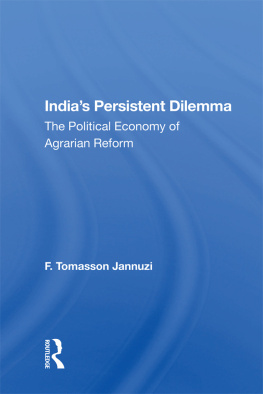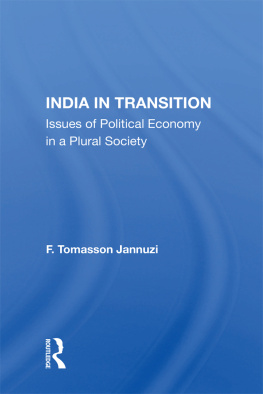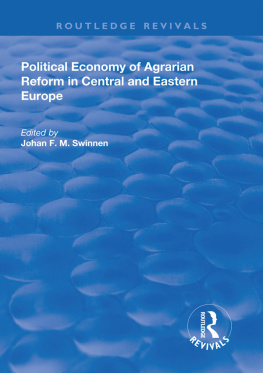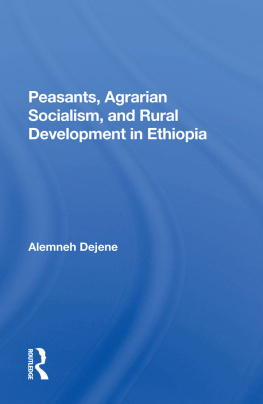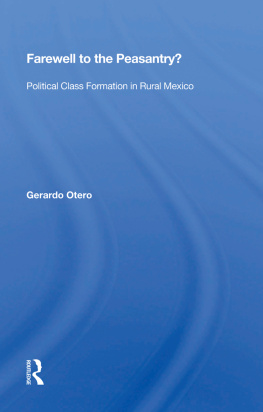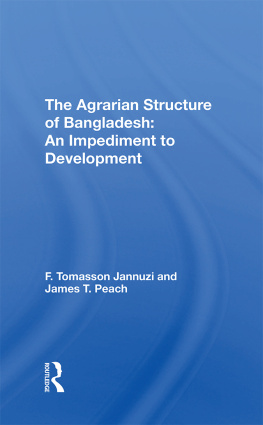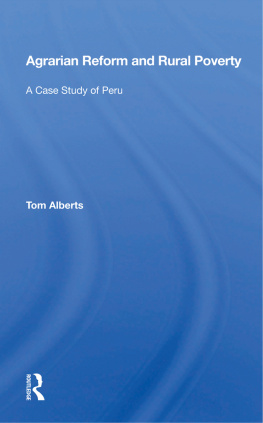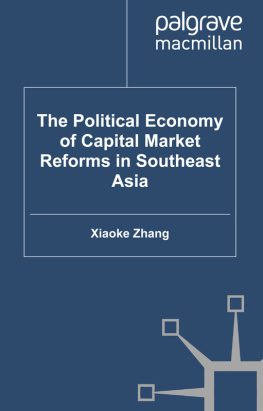First published 1994 by Westview Press, Inc.
Published 2018 by Routledge
52 Vanderbilt Avenue, New York, NY 10017
2 Park Square, Milton Park, Abingdon, Oxon OX14 4RN
Routledge is an imprint of the Taylor & Francis Group, an informa business
Copyright 1994 Taylor & Francis
All rights reserved. No part of this book may be reprinted or reproduced or utilised in any form or by any electronic, mechanical, or other means, now known or hereafter invented, including photocopying and recording, or in any information storage or retrieval system, without permission in writing from the publishers.
Notice:
Product or corporate names may be trademarks or registered trademarks, and are used only for identification and explanation without intent to infringe.
Library of Congress Cataloging-in-Publication Data
Jannuzi, F. Tomasson, 1934
India's persistent dilemma: the political economy of agrarian
reform / F. Tomasson Jannuzi.
p. cm.
Includes bibliographical references and index.
ISBN 0-8133-8835-X
1. Land reformIndia. I. Title.
HD1333.I4J36 1994
333.3'154dc20 94-538
CIP
ISBN 13: 978-0-367-01676-0 (hbk)
The Government of India in 1950 established within the context of the Directive Principles of State Policy in The Constitution of India a grand vision of socioeconomic change and a commitment to promote the general welfare of the mass of the people. Those who then constituted the Government of India following independence promised to promote the general welfare of the mass of the people, including the weakest and poorest sections of the citizenry in rural areas. This promise was to be fulfilled by means of state-led policies and programs designed to transform India's political economy. The promise was to ensure that the ownership and control of material resources were distributed in a fashion likely to contribute to the well-being of all citizens, providing thereby the basis for a new social order in which justice -- social, economic and political -- would be infused in the institutions of the new republic. It was intrinsic within the frame of the Directive Principles of State Policy that India's economic development agenda would require a commitment from those who governed to promote simultaneously both economic growth and social justice. Moreover, because the great majority of the people lived and worked in the agrarian sector of the economy -- a sector characterized by gross inequalities in the distribution of income, economic assets (notably land) and political power -- it was also intrinsic within the frame of the Directive Principles that the Government of India would undertake to promote the establishment of an economic system characterized by the empowerment of the people and, where necessary, by the redistribution of economic assets so as to limit sharply "the concentration of wealth and means of production to the common detriment." Agrarian reform, defined amorphously and variously by those who governed, was to become a principal means by which the commitments of the Directive Principles were to be made tangible in rural India.
Unfortunately, the Government of India has been unable to design, implement or promote the policies and programs of agrarian reform necessary to the fulfillment of its own articulated commitment to transform the political economy of rural India so as to ensure an improved distribution of economic assets, an improved environment for entrepreneurial opportunity for small farmers and an improved socioeconomic context where peoples' rights and opportunities are not constrained economically and politically within what I have elsewhere called "the traditional hierarchy of interests in land."
This book is an account of the failure of the Government of India to establish a coherent national program for agrarian reform in modern India -- a program, if implemented, that might have enabled India to emerge out of the shadow of British colonialism after 1947 to establish a new political economy based on new principles of public policy and democratic governance. It exposes the views on agrarian reform (and land reform) among those in India who, following independence, shaped public policy and proclaimed commitment in documents of state to the transformation of India's political economy to ensure that there would be created in time a new social order based not only on political freedom but also on economic justice. This new social order, suggested those who governed, would be designed to affect the well-being of the mass of the people in rural areas and would result from systemic changes in historical land systems. Such systemic changes would transform the conditions of production and distribution in rural India, helping thereby to ensure that the attainment of political freedom would not be an end in itself -- devoid of economic substance for the mass of the people.
This work is, also, an account of the failure of those who governed to translate pre-independence visions of agrarian reform and land reform into implementable post-independence programs capable of producing a more productive and just political economy. It shows how various post-independence visions of agrarian reform and rural economic development in India were conditioned by British colonial legacies (both legal and procedural), were articulated by Indians and others and then were either transformed, diluted and denied or, in some instances, slavishly adhered to in the period since India gained political freedom.
However, this book does not tell a story of venal leaders who sought consciously either to dismiss visions of a new political economy or to subvert plans for socioeconomic transformation of the Indian countryside. Neither is it the story of a conspiracy -- capitalist, socialist or some other -- to deny to the "tillers of the soil" in India their opportunity to live more secure and productive lives. It is, instead, a record of failure derived from a process, for the most part open and democratic, by which some people sought to introduce change in the political economy of rural India while others opposed change. It is the story of the mediation of opposing views by those who governed -- producing new visions and definitions of agrarian reform that ultimately would please neither those pressing for radical transformation of existing agrarian structures nor those who would have preferred no change at all in those structures. It is an account of a failure derived from a political process that, on the one hand, guaranteed India's landholding elites strong and continuous representation in the shaping of such agrarian reforms as were legislated and partially implemented, and, on the other, gave no meaningful voice to the people in the countryside who were to be the beneficiaries of agrarian reform: gave them no systematic means of ensuring that such reforms as were envisioned and enacted into law by the powerful would be designed to meet their needs, the needs of the powerless.
As a result of the Government of India's failure and the failure of most Indian states to enact into law and implement agrarian reform measures designed to transform its historic land systems so as to confer new rights and economic opportunities on actual cultivators, India now faces an uncertain future. India's existing political economy is one that denies generally its rural majority the socioeconomic changes long ago promised by India's Founding Fathers and made explicit in the Directive Principles. The existing political economy in rural India is shaped mainly, as it was prior to independence, by the interests of a minority of landholders whose political and economic power are derived from secure rights in land. This political economy works to deny both the socioeconomic changes promised by India's Founding Fathers and to thwart the needs and interests of the rural majority who lack secure rights in land. Such a political economy, where the economic power of a minority is used to deny the interests of a majority, cannot long persist in a society committed to democratic principles of governance -- a society within which even the weakest sections of the peasantry increasingly confirm by their daily behavior and their participation in general elections that they are capable of giving expression to their needs. In the days ahead, the functional meaning of India's democratic society will be tested as the people at the base of her agrarian economy gain in their ability, both within and outside of the institutionalized political process, to press for change in existing conditions.


